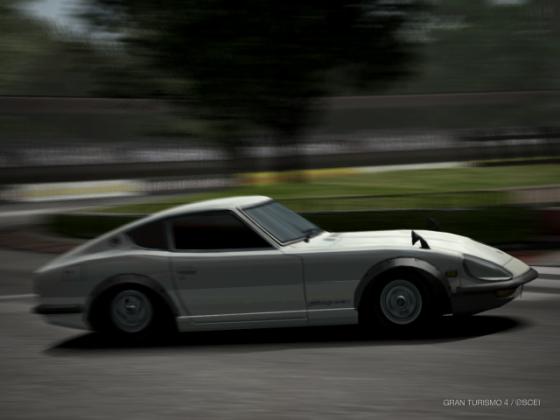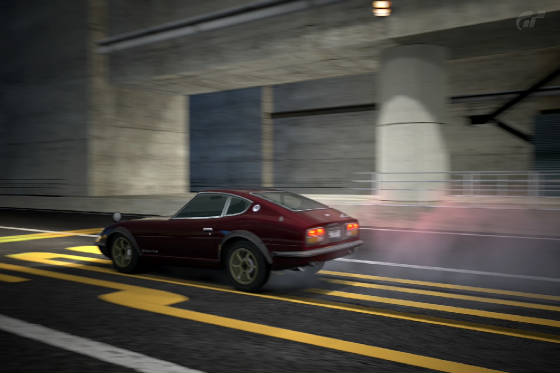|
Year: 1971
Class: Sports Car
Type: 2-door coupe
Country of Origin: Japan```````````````````````` Host: GT2, GT4 & GT5
Price as Tested: $23,702 (GT2 used lot)
$46,749 (when traded in GT4. must be won, otherwise.)
$54,218 (GT5 used car lot)
Length: 169.5" / Width: 66.5" / Height: 50.5"
Wheelbase: 91"
Track front & rear:
@53"
Overhang: @6 feet 6.5"
Ground Clearance: 6.3"
Curb weight: 2,226 lbs.
Tires: 6.45H x 14
Brakes: solid
disc / drum
Suspension: independent struts front & rear, coils, anti-roll bars, shocks
Layout: Front engine / Rear drive
Engine Displacement: 2.4 liter OHC inline-6
Aspiration:
normal -
Fuel syst: 2 barrel carb.
Valves / Cylinder: 2
Compression Ratio: 9.0:1
GT2 Redline: 6,500
// Rev Limit: 7,000
GT4 Idle: 1,000 // Redline: 7,000 // RPM Limit: 7,500
GT5 Idle: 625 // Redline: 7,000 // RPM Limit:
7,500
*Oil change performed on the cars in GT4 & GT5 for stats and track testing below.
The GT5 car also got an engine rebuild.
GT2 Horsepwr:155 @ 5,600 rpms
GT2 Torque: 152 @ 5,000 rpms
GT4 Horsepwr: 156 @ 5,600 rpms
GT4 Torque: 159 @ 4,800
rpms
GT5 Final HP: 156 @ 5,500 rpm
GT5 Fnl. Torq: 159 @ 5,000 rpm
Lb. / HP ratio: 14.36
(GT2) // 14.27 (GT4) // 14.33 (GT5)
Hp per liter: 64.58 (GT2) // 65.7 (GT4) // (GT5)
Credits per HP: $81.95
(GT2) // $299.67 (GT4) // $347.56 (GT5)
Transmission: 5-speed manual
Differential: open
0-60 mph: GT2: 9.0xx seconds
GT4: 8.266 seconds GT5: 8.489 seconds
0-100 mph:
GT2: 23.0 seconds GT4: 20.566 seconds GT5: 21.137
seconds
400 M: GT2: 16.740
@ 85 mph GT4: 16.551 @ 91
mph GT5: 16.857 @ 90 mph
1 KM: GT2: 30.948 @ 103 mph GT4: 29.433 @ 116 mph GT5: 29.796 @ 115 mph
Brakes: 100-zero: 4.18 seconds (GT4), 4.85 (GT5)
Top Speed at 7,000 rpm (GT2)
1st: 38 mph
2nd: 63 mph
3rd: 89 mph
4th: 117
mph
5th: 138.0 (rpm limited)
Top Speed at Redline (GT4)
1st: 44
mph
2nd: 69 mph
3rd: 102 mph
4th: 133 mph
5th: 140.70 mph @ 6,300 rpms
Top Speed at Redline (GT5)
1st: 44 mph
2nd: 65 mph
3rd: 97 mph
4th: 128
mph
5th: 138.5 @ 6,500 rpm
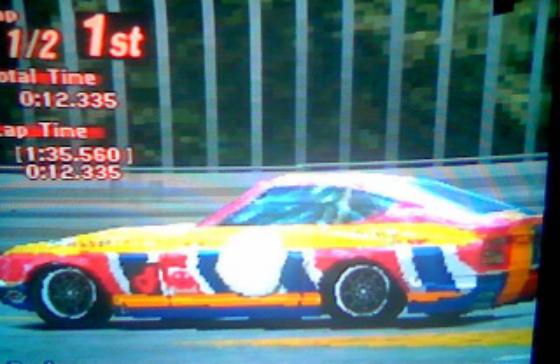
---------------------EXTERIOR--------------------
What a surprise to start up GT2 and find an original Z car in the vast library
of used Nissans! And not just any Z car. What we have here is the "G" version...which essentially was created for amateur
racers of the early '70s as the new Z took the racing world by storm. To find such a car in my game was totally unexpected,
and for just $23,702, the 240Z-G is affordable, too. It's mine!
This is a rare example of
an automobile going UP in value as it ages, since these cars cost around $3,000 (about $12,000 of today's dollars) when they
were new. But check this out. From 1999 when GT2 was released, to 2010 when GT5 was released, the car's price has climbed
astronomically. I just got one in the latest game for $54,218! This implies there must be something special
about this 40 year-old car. What could it be?
When I was a kid, my neighbor had a 240Z. Or maybe it was
a 280Z. It was orange and rusted, despite being just a few years old. Now that I know more about cars, I've learned that Japanese
cars from this era used cheaper grades of steel that did not last long before rust and corrosion set it. But back when
I was a kid this didn't matter. That old rusted piece of junk was where my obsession with the Z began.
In America, Nissan used to be known as Datsun, till they changed their name for some reason. The 240Z was
their shining star: it rocked the western world with its low price, sporty design, flexy handling, and relatively fuel-efficient
engine. Up till this point, the only small sports coupes found in America were from England, Germany, or Italy, and most of
these were rather unreliable in the long run. If you had an MG or a Porsche and needed to fix it, parts could cost a lot of
money, sometimes they even had to be imported. Generally not so with the mass-produced Datsun.
American sports cars and coupes were often heavy, with gigantic engines. An open market existed for
something smaller, more fuel-efficient, inexpensive, yet sporty; and Datsun was the first to fill it on a mass-produced level
before a slew of others came along. The 240Z eventually outsold many American vehicles, which went the way of the dinosaur
as gas prices rose.
The 240Z isn't the fastest car in GT2, 4, or 5, but aftermarket parts will make it competitive against
modern vehicles. Even when stock, this 28 year-old coupe (assuming we're discussing GT2 when it was released in 1999) holds
its own against cars of similar weight and horsepower, although it does better in some games than others.
In GT2, the graphic designers did as good of a job as they could detailing the Z with the Playstation's
maxed out lo-res system: there are visible bubbles over the headlamps, bonnet-mounted mirrors (both of these features can
only be found on 240s from countries outside America), chrome detailing around the windows, and a rear air spoiler + wheel
flares. This is an automobile from another era, yet it's also the forerunner of all the modern Zs and the 240SX as well.
Eventually, the Z got bigger. First, there was the 260Z with its slightly longer wheelbase & body,
then the 280Z followed. Finally, the 280ZX appeared in the early '80s, which was the first Z to feature more of a luxury-oriented
approach. A 1978 280Z and a 1983 280ZX can be had in GT4 or 5, but not in earlier games. Since the 280Z is of the
same generation as the 240Z, I'll chat about it for a moment.
When Nissan/Datsun created the 260Z, they added a larger 2.6 liter engine. Even though displacement
was up, American fuel-economy restrictions robbed this engine of power; so that countries outside of America got a stronger
car than we did. To counteract this problem, the engine was upgraded again to 2.8 liters just a year later; hence, the "280"
designation. Unfortunately, power only rose from 137 hp to about 150....which means the 280Z in GT4 possesses about the same
power as a 240Z. At 2,700 pounds, it is also heavier! Oh well. In my opinion, the 280Z is still a potent machine, and looks
slightly more mature. It's also a 2-seater. That's a plus.
So like I said, after the 280Z came the 280 ZX. Next, the 300ZX first appeared towards the end
of the '80s...and finally we have our modern 350Z. These cars resemble the shape of the original Z, but are stockier....their
body-shape looks bulged, like somebody stuffed the car into a giant sock. The 300ZX and 350Z are less defined than
original Zs, in my opinion. They are also heavily-laden with features and gadgets....not like the cheap, sporty
vehicle that started it all. So it's cool to see where it all started with the Datsun 240Z in our games.
The 240Z can only be found in just a few colors. If you don't like the one you see, eventually another
may show up with a different shade. I'm not sure how many there are, but so far I've seen white, red, and maroon. I saw a
black one racing in the '80s car series, too. :drool: In GT2 and GT5, the 240Z only shows up one at a time; always in the
used lot. It's not easy to find, so if you see one it's a good idea to just buy it if you're a fan and you've got the money,
otherwise it could be a long time before the chance comes up to purchase one again in your favorite color. In GT4, the 240Z
is a prize given after completion Nissan's Z-Car Series....but a 280Z can be bought at any time from the "Classic" section
of Nissan's dealership.
Modern Z cars tend to be a bit longer in both length and wheelbase...but track, width, and height aren't
much different from a 240Z. The 240Z weighs about 1,200 pounds less than the 300ZX (amazing), but just 300 less than
the 240SX Fastback. Weight reductions barely take a total of 200 pounds off the 240Z in GT2, so this is one
of the options one can wait on while other portions of the car are upgraded. A GT4 240Z will weigh 1,957
pounds with all 3 reductions in place...269 pounds lighter than stock. GT5 we can get even lower since the
car's windows can be replaced: 1,891 pounds in this game. Now, a bit of history on this car.
When introduced to Americans way back when, Nissan/Datsun was not immediately interested in racing 240Zs.
At the time, Nissan Skylines (known as Datsun 510s in America) were just making headway in circuit racing, so Nissan was basically
concentrating on these instead. What happened next was not planned.
At a car show, race-driver Bob Sharp happened to see a 240Z. This was essentially the first 240Z in
America at the time, according to info I've read from several websites. Bob was so taken by the car, he immediately contacted
somebody over at Nissan so he could purchase one. Turns out, there weren't any for sale yet. The car moved on to the next
show in Toronto. Here, a clueless model-girl apparently sat on the roof of the 240; denting it to the point that it could
not be pulled back to shape, and was therefore now useless as a show-stopper. Bob was contacted in secret, and the dented
240Z was now sold.
Lucky for him, he already had an "in" from Nissan/Datsun since he had raced several of their cars, so
it apparently didn't take much time for Bob to convert the dented show car into a racing demon. Over the next 5 years,
he garnered many SCCA C-class wins in Z cars, and so did Peter Brock, Paul Newman, Paul Bondurant, and several other
famous (and not so famous) drivers. Zs also saw action in safaris and pavement races all over the world, quickly earning it
rep.
Any car's heart begins with its powerplant. Let's have a look.
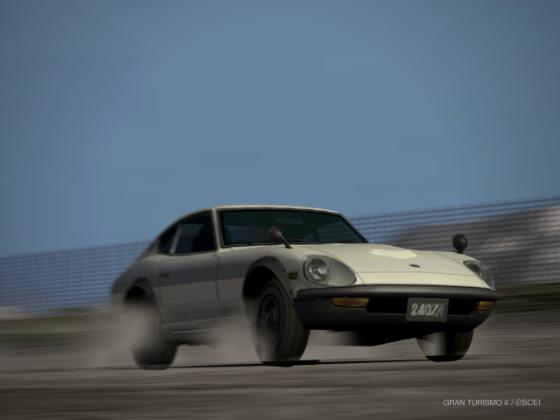
| The 280Z L |
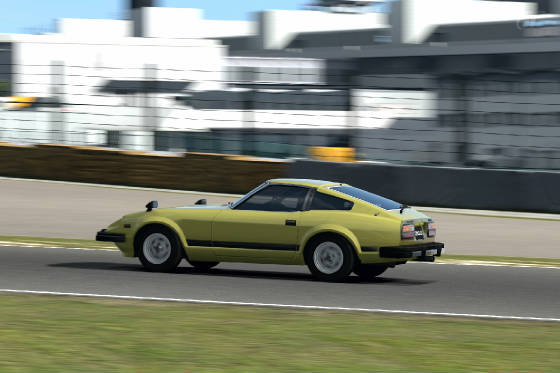
|
| ...notice its more fastidious shape & demeanor... |
-----------------ENGINE / DRIVETRAIN------------------
Despite its age, the 240Z stands up to modern GT competition.
Its 2.4 liter OHC inline-6 motor is a bit underpowered, but this can be easily remedied.
In addition to the engine computer, normal-aspirated tuning, and other standard upgrades we can buy, the 240Z engine can also
handle the rarely-found displacement increase. Getting this service costs $8,500 in GT2, and only adds 3 horsepower, but it
also gives the car a bit more lower-end torque. We can not (for whatever reason) buy an increase in GT4.
Despite lack of power, easier races can be won even before the Z's engine has been modified heavily,
since this car has other attributes that keep it an early winner. Once we start to modify, we shall find that the
higher-end parts cost a lot of money. In GT2, NA Stage 2 costs $13,500, but this is ghetto food compared to Stage 3,
which costs a whopping $75,000! This will provide a total of 324 hp @ 7,500 rpm
in GT2. Costs alot, true,....but you can also win alot. The GT4 car also gets 3 NA tunes, no turbos, yet
can only be pushed to about 303 hp @ 5,600 rpms at the most. The good news
is that each tune (in either game) does add a substantial amount of power over the next.
In GT2, peak rpm is off...7,000 tested vs. 5,600 quoted, but this is not so in GT4. Truthfully, peak
power is supposed to show up at about 5,600 rpms, but PD apparently screwed up with GT2's car. No matter how
much the motor is modified, it develops its best power near redline in the 2nd GT, yet torque falls off dramatically
above its mid-5,000 peak. But in GT4, things are different, just as they are with 4th-generation Camaros & Corvettes. You'll
notice a "swell" of horses in the mid-5,000s, where it should be, in GT4.
But in either game, this
means that the car can reach good speed (I only reached 138 in GT2, but this can be improved with the racing
gearbox), but that it takes awhile to get there. The GT4 car has a different powerband, higher RPM limit, and seems geared
differently or something, because I could eke a couple more mph from it (140.7), yet the engine
was revving 700 rpms shy of redline. This sort of performance may seem sub-par when compared to modern Zs, but this is mostly
due to the technology of small-engines at the time. After all, the 240Z was made during the age before turbos, double-overhead
cams, and electronic fuel-injection became popular in small engines.
In GT2, 0-60 mph was acheived in about 9 seconds, and 100 came after a full 23.
GT4 had lower times than these, oddly, by many tenths of a second! But still, this is kind of a sad start. Good
thing the 240Z is a light car; otherwise, this mediocre performance would be even worse. The engine was fueled
by a 2-barrel carburetor, which works well if there's a huge block sucking gas below it, but twin carbs just don't
cut it with a small 6. In the 280Z, fuel-injection was featured instead of carbs, not that this made things much different.
Gearing is evenly spaced, though 3rd is a bit short and 4th is a bit tall. And (again), the car in GT4
seems geared differently. In either game, this is a car that eventually demands use of a full-racing
gearbox if it is to acheive a higher top speed. I wouldn't mess with close-ratio gearing in GT2, but in
the 4th game it comes in handy at some tracks, especially off-road!
So, not really a motor which can be accused of being hot-headed. But this car isn't (and has never been)
just about power anyways...
-----------------CHASSIS / HANDLING--------------
Modern Z cars feature firm, predictable handling and tight suspensions, so how were
things back in the '70s?
This portion of the original Z (its suspension & chassis) is a bit wallowy and more flexible than
later Zs, but otherwise does just fine since the weight above it is low. The 240Z's habit of leaning thru corners is caused
not just by weak coils all around, but also 6.3 inches of ground clearance. Yikes! But still, the 240Z was
able to run circles around many others of its day, and I'm happy to say that this car (and let's add the 280Z of GT4 and 5 as
well) are both highly nimble and responsive machines, even when stock on crappy tires.
These early Zs were built during
an era when many passenger and sports coupes still featured live rear axles and downsized truck suspensions, yet the 240Z
has a fully independent setup with struts, coils, and anti-roll bars front and rear, which helped it win a few back in the
day despite its lowish power.
GT2
I've
been driving the 240Z around beginner's races in GT2 (including ones that have horsepower limits) and have found that it will
handle these forays with stock tires and suspension and still conquer.
For more advanced races (including
some of the A-license series) either a sports or semi-racing suspension can be used with sports car tires, which will make
the handling better and also more fun. "Fun". That's the key word here. The light weight 240Z will do things a heavier 300ZX
will balk at. You can HURL the Datsun through turns, purposely oversteering, and it will comply with all but the most absurd
demands. This is true in GT2 and GT4, actually.
When it comes to rally racing, you may be pleasantly surprised. All
the rules are different! In fact, they're more pronounced. I found that I actually had a hard time getting the
Z car to drift & slide in the dirt...understeer was much more of an annoyance as I tackled the Pike's Peak Downhill
course against the Peugeot 306 in GT2. All the usual tricks (more rear camber, toe out, stiffer stabilizers, stronger rear
brakes...) were employed, and I had a full 6 degrees of rear camber before the car was behaving the
way I wanted. Under throttle, it will now need taming, which a simple flick of countersteer will do.
The brakes
are okay. You can use Datsun's factory brakes in GT2 for a good while before upgrading, but in GT4, you'll benefit earlier
from better parts. This car features discs up front and drums in the rear, and is planted on skinny 6.45 inch radials. Under
intense braking it will have problems... mainly understeer, with an occasional tendency to fishtail. So it's important to
make sure to brake early before tight corners in GT2; where light cars have a tendency to suffer from longer brake-distances
than they do in GT4.
GT4
You'll
be pleasantly surprised to find the 240Z-G, as well as the '78 Datsun 280Z-L, have many positive traits that didn't get
"ruined" during the transition from first-gen consoles to 2nd. Take understeer, for example...or a lack of it!
Even under heavy braking, these cars still can still be steered into corners. They can be braked rather late when
they're on sport tires, despite their antiquity. For this reason, steering remains fairly accurate. This was the main
shock. Trail-braking can be mighty fun and addictive in these cars.
Wheelspin starts to show up (with sport tires)
once Stage 1 tuning is being used, but it is minimal. Understeer starts to finally show up during faster-paced events,
yet is easily tamed by being careful with the gas. There is also oversteer-on-demand, much like you'd find in a
later FC-series RX-7 or Corolla, which is fun; for these cars occasionally slip and slide when we want
them to, but are generally controllable with minimal understeer and light lift-off oversteer at the limits, and so is this
ancient Z.
But to make all this happen, the Z will need limited-slip devices and suspension
tuning earlier than in GT2, mostly because this later game features more wheelspin if these parts aren't bolted.
It also helps with oversteer and drifting to have at least a 1-way LSD packed between the rear wheels.
The only really negative things to watch for are occasional, sudden oversteer, and maneuverability
that is too maleable (flexy / bendy).
Sudden oversteer (accompanied by LOTS of wheelspin) can occur
if the Z hops off a curb with too much enthusiasm. All a sudden, all its power is now being sent to one rear wheel
instead of two, just as it would be in any muscle car. So watch for this.
The "maleable" maneuverability part is
how I would describe this car before it's had a Rigidity Refresh or a $30,000 rollcage put in. There is too much
movement in the undercarraige and body, even with low mileage. It's cool in a way, mostly when you're just messing around
on an empty track, but this sometimes can ruin cornering-lines during actual races. But as I
said, a rollcage removes most of this behavior. The downside is the car starts feeling somewhat "sterilized" and generic
with the roll-cage. Slightly more understeer shows up, too, along with less of that fun lift-off trail-braking oversteer.
....So
some of you may find the way this car dances around desireable, and might not want to change a thing. Don't buy the
rollcage if this describes you! The Rigidity Refresh costs more, but it will stiffen up the car's handling without making
it feel like a newer Skyline.
Off-road, the GT4 240Z-G is still a great rear-drive car! A strongly-tuned limited-slip
(or at least a 2-way unit) is needed tho, because now the car is prone to some rear-end sliding (unlike the GT2 car); which
can mostly be avoided if the throttle isn't hammered going into or coming out of tight corners. Special settings aren't
needed to make this happen...in fact, you may find the Z spending a fair amount of time setting up the 240 just
to avoid this behavior.
But most of the time off-road, the 240Z has great traction, just as it does in GT2.
I suspect it has something to do with the lack of torque the engine generates, but whatever; it's still a plus.
GT5
In this game, we've got an
even broader list of behaviors to explore since ABS can now be turned off, and steering input can also be manipulated.
The car is still flexy and fun, yet it is now also dangerous at times!
One must be careful
with this car entering corners. Its front-end has a habit of wanting to please the driver while braking, even on the car's
stock Comfort Soft tires. Problem is, now the rear can get into some wicked snap-spins (or at least an evil twitch
here and there) if one is not delicately handling this vehicle into turns.
After driving and racing my dark reddish-colored
240Z around many tracks, I finally think I'm starting to get the sense of where the "Z" part of this car's name could possibly
be inspired from, for it truely does Z a lot...as in zig-zag! Lots of positioning and re-positioning mid-corner.
Lots of surprises.
For the Z cars of GT4, I mentioned how instant wheelspin can happen if one steps
off a curbing with a little too much enthusiasm. Well in GT5, wheelspin just happens. It can show
up at any time, simply if the 240 or 280Z is leaning a little too much out of a turn, gas shoved a little too hard. This car
is like ten times as fishtaily as it was in earlier GTs if you want it to be. If you don't want it to be this way, of course,
there are options. Similar options to earlier games: mostly and suspension limited-slip tuning can come to our rescue.
Or just simple fuel-pedal gauging. That works too. Sometimes.
So the entire package has really improved
in this game. It is just as tossable as it was in GT2, but feels more daring than it was in GT4. We can perform many stunts,
entering corners with just a smidge too much steering input, getting the car slightly sideways while we skate past
a heavier BMW. Give a few more steering nudges while coasting, and the lightweight Z gets into a slippery orbit. Now, drop
the throttle! The rear end responds with more force than ever before while the engine ROARS! Because of all
this, the Z car as modeled by PD is at its peak!
Summary:
So overall, I think the 240Z-G rules. And it changed
many rules of its day.
------------------------ PROS------------------------
1). Sporty Japanese looks found on no other car in GT (except the Toyota 2000GT).
The long-hood / short deck habit so many muscle-cars at the time possessed didn't look "copied" from American vehicles when
Nissan employed them on the Z. Instead, the 240Z had its own unique profile, its own distinctiveness.
2). Lightweight, but not too light. Reductions aren't needed immediately.
Racing body can be had in GT2.
3). Affordable. In GT2 anyways. By the time GT4 came out, Z-cars seem to have doubled in value!
In my opinion, they're still not overpriced, though.
4). Easily upgraded.
5). They handle well despite their age. In the hands of an intermediate
player, these early Z-cars can compete against modern vehicles with surprsingly little help. The 240Z can enter and win
a decent amount of races even when underpowered.
6). In the game, 240Zs have stock tires which feel appropriate, allowing some slip mixed
with lots of grip (GT5 is more slip, less grip, though). For this reason these cars are incredibly fun and "tossable". Rarely
will slicks or racing tires be needed in GT2 if you've got some experience. Sport tires come in handy earlier in GT4
and 5, though.
7). Minimal understeer....controllable oversteer. ++
8). Relatively fuel-efficient (GT4 &
5).
9). Drifty fun in GT5! Not so much in earlier games, where torque-caused wheelspin isn't as great.
10).
Gotta love that melodic straight-6 engine note. Brrrrrrrrbbbbrbrb!!! From game to game (GT2...GT4...GT5) it only gets
more and more fantastic.
--------------------------CONS----------------------
1). Rare and hard to find in GT2 or 5! This
car is hard to find and easy to miss if it does happen to appear in the used car lots. In GT4, a 240Z can only be won
as a prize from the Z-Car Challenge, or traded off another memory card.
2). Stage 3 engine parts cost $75,000, yet only provide 324
hp (GT2) or 303 hp (GT4).
3). Poor torque kills this car's acceleration early and quick.
4). Stock gearing seems taller than it is during races, where the underpowered
240 and 280Zs struggle with speed from time to time.
5). Poor top-end caused by a short 5th gear (GT2 mostly). A racing
gearbox is needed to cure this.
6). Also in GT2: PD screwed up the power-band...forcing us to take it all the way to
redline to get max power.
7). Limited-slip devices come in handy early as power is raised to
Stage 1 tuning (GT2) or even for stock cars on N3 tires (GT4) or Comfort Softs (GT5). These primitive Z-cars have tons of
flexibility as rear-drives, but are also prone to alot of squishiness and light fishtailing as power gets planted out of corners.
8). GT2: many have been shocked by the garish racing body with
its contrastingly ugly color scheme!
9). Not a car for beginners, despite their fun nature and lowish power.
Published: July 7, 2004
Edited for GT4 content: sometime in 2007 or 2008.
Edited for GT5 content: March 15, 2011
|



